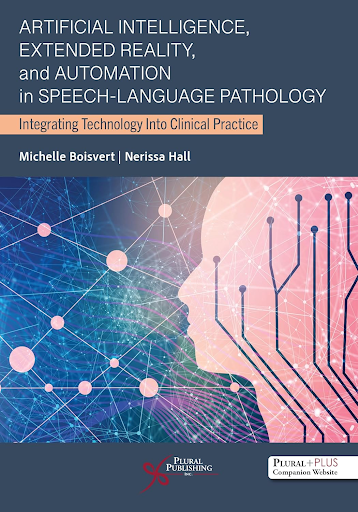Artificial Intelligence
Come here to learn about what colleagues and I are thinking, learning, and doing with artificial intelligence in the field of communication disorders.
Artificial Intelligence, Automation, and Extended Reality in Speech-Language Pathology: Integrating Technology Into Clinical Practice
Section II: Artificial Intelligence In Speech-Language Pathology
Foundations in Artificial Intelligence In Speech-Language Pathology
Yao Du, Lori Price, and Kathryn Lubniewski.
The Future of Artificial Intelligence In Speech-Language Pathology
Lori Price, Kathryn Lubniewski, and Yao Du.
I’d love to hear from you about your work with Artificial Intelligence and speech language pathology.
If you have a reference to share, or an idea to discuss, please let me know. I’d love to meet you.
References
Abou-Abdallah, M., Dar, T., Mahmudzade, Y., Michaels, J., Talwar, R., & Tornari, C. (2024). The quality and readability of patient information provided by ChatGPT: can AI reliably explain common ENT operations? European Archives of Oto-Rhino-Laryngology, 1-7.
Azevedo, N., Kehayia, E., Jarema, G., Le Dorze, G., Beaujard, C., & Yvon, M. (2024). How artificial intelligence (AI) is used in aphasia rehabilitation: A scoping review. Aphasiology, 38(2), 305-336.
Brown, J., Ackley, K., & Knollman-Porter, K. (2021). Collaborative goal setting: A clinical approach for adults with mild traumatic brain injury. American Journal of Speech-Language Pathology, 30(6), 2394-2413.
Campbell, D. J., Estephan, L. E., Mastrolonardo, E. V., Amin, D. R., Huntley, C. T., & Boon, M. S. (2023). Evaluating ChatGPT responses on obstructive sleep apnea for patient education. Journal of Clinical Sleep Medicine, 19(12), 1989-1995.
Cella, D., Lai, J. S., Nowinski, C. J., Victorson, D., Peterman, A., Miller, D., et al. (2012). Neuro-QOL: brief measures of health-related quality of life for clinical research in neurology. Neurology, 78(23), 1860–1867.
Ciaramelli, E., Neri, F., Marini, L., & Braghittoni, D. (2015). Improving memory following prefrontal cortex damage with the PQRST method. Frontiers in behavioral neuroscience, 9, 211. https://doi.org/10.3389/fnbeh.2015.00211
Filienko, D., Wang, Y., Jazmi, C. E., Xie, S., Cohen, T., De Cock, M., & Yuwen, W. (2024). Toward Large Language Models as a Therapeutic Tool: Comparing Prompting Techniques to Improve GPT-Delivered Problem-Solving Therapy. arXiv preprint arXiv:2409.00112.
Hart, T., Driver, S., Sander, A., Pappadis, M., Dams-O’Connor, K., Bocage, C., Hinkens, E., Dahdah, M., & Cai, X. (2018). Traumatic brain injury education for adult patients and families: a scoping review. Brain injury, 32(11), 1295-1306.
Hinckley, J., & Jayes, M. (2023). Person-centered care for people with aphasia: tools for shared decision-making. Frontiers in rehabilitation sciences, 4.
Imaezue, G. C., & Goral, M. (2024). Toward Self-Regulated Learning in Aphasia Rehabilitation: A Proposed Framework. Aphasiology, 1-16.
Medley, A. R., & Powell, T. (2010). Motivational interviewing to promote self-awareness and engagement in rehabilitation following acquired brain injury: A conceptual review. Neuropsychological rehabilitation, 20(4), 481-508.
Ponsford, J., Velikonja, D., Janzen, S., Harnett, A., McIntyre, A., Wiseman-Hakes, C., Togher, L., Teasell, R., Kua, A., Patsakos, E., Welch-West, P., & Bayley, M. T. (2023). INCOG 2.0 Guidelines for Cognitive Rehabilitation Following Traumatic Brain Injury, Part II: Attention and Information Processing Speed. Journal of Head Trauma Rehabilitation, 38(1), 38–51.
Pegg Jr, P. O., Auerbach, S. M., Seel, R. T., Buenaver, L. F., Kiesler, D. J., & Plybon, L. E. (2005). The Impact of Patient-Centered Information on Patients' Treatment Satisfaction and Outcomes in Traumatic Brain Injury Rehabilitation. Rehabilitation Psychology, 50(4), 366.
Pei, Y, & O’Brien, K. (2021). Reading Abilities Post Traumatic Brain Injury in Adolescents and Adults: A Systematic Review and Meta-Analysis. American Journal of Speech-Language Pathology, 30(2), 789-816. https://doi.org/10.1044/2020_AJSLP-20-00213
Price, L., Lubniewski, K., & Du., Y. (2024). Using ChatGPT to Create Treatment Materials. ASHA Leader Live, March/April 2024.
Vallurupalli, M., Shah, N. D., & Vyas, R. M. (2024). Validation of ChatGPT 3.5 as a Tool to Optimize Readability of Patient-facing Craniofacial Education Materials. Plastic and Reconstructive Surgery–Global Open, 12(2), e5575.
Walker, H. L., Ghani, S., Kuemmerli, C., Nebiker, C. A., Müller, B. P., Raptis, D. A., & Staubli, S. M. (2023). Reliability of medical information provided by ChatGPT: assessment against clinical guidelines and patient information quality instrument. Journal of Medical Internet Research, 25, e47479.
World Health Organization. (2015). WHO global strategy on people-centered and integrated health services: interim report (No. WHO/HIS/SDS/2015.6). World Health Organization.
Yeo, Y. X., Pestell, C. F., Bucks, R. S., Allanson, F., & Weinborn, M. (2021). Metacognitive knowledge and functional outcomes in adults with acquired brain injury: A meta-analysis. Neuropsychological Rehabilitation, 31(3), 453–478.
Zalzal, H. G., Abraham, A., Cheng, J., & Shah, R. K. (2024). Can ChatGPT help patients answer their otolaryngology questions? Laryngoscope Investigative Otolaryngology, 9(1), e1193.
Zhenzhu, L., Jingfeng, Z., Wei, Z., Jianjun, Z., & Yinshui, X. (2024). GPT-agents based on medical guidelines can improve the responsiveness and explainability of outcomes for traumatic brain injury rehabilitation. Scientific Reports, 14(1), 7626.

